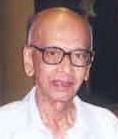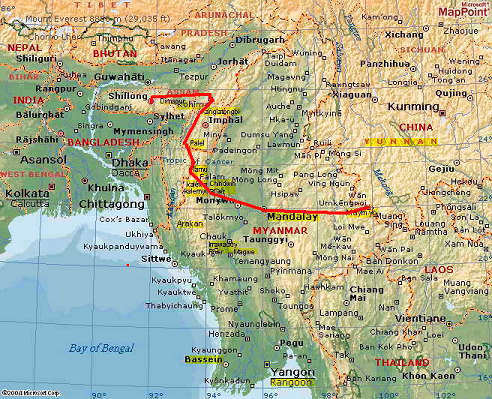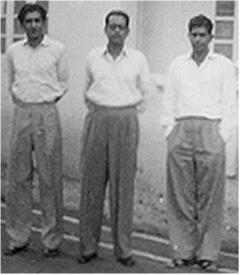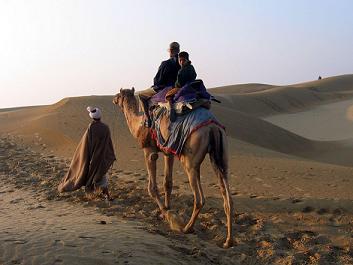Latest Contributions
Read More Contributions
Barefoot from Burma to India, 1942 by Benegal Dinker Rao
Category:

Benegal Dinker Rao, born in 1917 in Rangoon, graduated from the University of Rangoon in 1938, and joined the Education Ministry, Government of Burma. After his walk from Burma to India in 1942, he joined the Refugee Government of Burma in Simla. In 1943, he joined the Indian Army Ordnance Corps. He resigned from the Corps in 1952 to work for a Calcutta-based British engineering company, from which he retired as Marketing Director in 1978 and moved to Pune. Presently, he is a consultant and partner in a Partnership firm.
Editor’s note: This story has three parts. Arvind Benegal, a nephew of Benegal Dinker, is the author of the first part, based on his uncle’s oral accounts, who remembers the events of 1942 clearly and precisely.
The Japanese Air Force first bombed Rangoon (now Yangon) on December 23, 1941. Then again on December 25, this time with incendiary bombs. Burma (now Myanmar) was part of the British Empire, and was now part of the Second World War. Soon after, the Japanese Army invaded Burma.
I was 24 years old, living in Rangoon as an employee of the Government of Burma. My family consisted of my mother, Kalyani Bai, and two younger brothers, Sumitra and Ramesh. We also had with us, Madiman Dutta, 80 years old, a faithful elder servant who had been attached to our family for so long that he was treated as a family member.
Most Indian families left Burma for India as soon as possible\; they traveled by sea from Rangoon to Calcutta (now Kolkata). However, I could not leave Burma because I was classified as an “essential” Government employee who had to stay on in Rangoon. Nevertheless, I did not want to expose my family to the ongoing bombing in Rangoon. So I arranged to send my mother and brothers to Bassein, in southwest Burma, on the Bay of Bengal, which was not being bombed.
By mid-January 1942, the Japanese were bombing Rangoon night and day. Food became scarce\; law and order broke down. My friend M.G. Mankikar had also stayed behind in Rangoon as he too was classified as an “essential” Government employee. He and I moved to the suburban bungalow of Dr. P.G. Gollerkeri, where we dug an air raid trench, and stocked it with some drinking water and a little food.
Soon we were forced to live in the trench as the bombings increased in frequency and intensity. During one air raid, when I was out in the open, en route to an air raid shelter, a bomb landed a few yards away from me. I threw myself flat on the ground and thought it was the end. But the bomb did not explode – there was just a huge crater where it had landed.
Before my mother and brothers left Rangoon, my mother had fried a jarful of Mirsange Kachris, (fried dried chillies), one of favourite condiments. One day in late February 1942, after two days of starvation, I swallowed the Kachris with a few drops of rationed water. You can imagine the painful consequence to my digestive system!
When Singapore fell to the Japanese in February 1942, we knew that Rangoon would fall soon. We sent word to our families to go overland to India via Arakan and Chittagong, which is what they did. By the end of February 1942, the British and Indian troops left Rangoon, and the Government of Burma officially moved to Maymyo, a hill station in the Shan state on the border of Yunnan (China).
Maymyo is a plateau, ringed on three sides by mountains\; the fourth (open) side is connected to Mandalay by rail and road. The Japanese had driven through Yunnan and were on the mountains ringing Maymyo, taking shots at anything that moved. So we spent the daytime in trenches, coming out only at night. There was no electric power at all, but even a lit cigarette or a torchlight could attract sniper fire.
The Government of Burma declared itself defunct in mid-April 1942, with the idea that a small Government-in-exile would be set up in India, perhaps in Delhi or Simla. Government servants were told that they could either remain ‘as is where is’ and surrender to the Japanese, or could make their way to India at their own risk. Mainmath and I decided to make it to India, fairly certain that our families were safely settled there.
On April 21, 1942, Mainmath and I started our trek from Maymyo to India. The distance is about 520 km (320 miles) as the crow flies – and much more than this on the ground. We did it in 34 days by whatever means we could get hold of – walking, by raft, and an occasional lift from someone in a motor vehicle.

When we reached Mandalay, the city was burning. The Japanese had firebombed it that morning. The fire was devastating because all the houses were made of wood. In the Mandalay railway station yard, we found ourselves surrounded by burning debris, and soldiers and civilians dead or dying from cholera or black water fever. We were dying of thirst. The only safe water available was from the boilers of railway engines. The water was full of coal ash and wood ash – but we drank it as if it was nectar from Heaven itself.
In Mandalay, we came across an Indian army unit of the Survey of India. Fortunately for us, the Officer-in-Charge was a Benegal Pandurang! He gave us some bread from his unit’s rations. His unit had been asked to destroy all records, arms, equipment, and to get to India by the Mogaung-Ledo route up the Irrawaddy.
Mainmath and I planned to take the Tamu route to Manipur up the Chindwin River. From Mandalay, we trekked to Kalewa, which is located at the confluence of the Chindwin and Myittha rivers. From Kalewa, instead of walking, we would float on the Chindwin River on improvised rafts – tree branches tied with anything that could hold them together. But, even before we took off, we were looted by Burmese/Chin dacoits, who took away everything we had, leaving Mainmath and me in our vests and shorts – nothing else.
There were other India-bound families along with us on rafts on the Chindwin River. Some distance from Kalewa, the river flows through a gorge with sheer white cliffs. The monsoon had just broken in upper Burma and a tidal-bore type of flood came down the river, lifting our rafts a good 50-100 feet. One raft had a family with two children. They bore the brunt of the flood-wave, as the children were flung into recesses halfway up the cliffs. The raft with the parents came down to pre¬-flood levels and uncontrollably floated downstream. Birds, eagles and/or hawks were circling and pecking at the terrified children. A ghastly end...
Once we reached Kalemyo, we had to walk – barefoot, as we had no shoes. Our first target was to reach Tamu on the Burma/Manipur border, and then onto Palel. Between Tamu and Palel, when Mainmath and I were plodding in torrential rain, we came to an abandoned cattle shelter with a half-torn thatch roof. We were too exhausted to walk any more. When we lay down in the slush, we realized that there was a half-bare woman and a naked child lying there moaning. But we were so tired that we fell asleep. When I woke up, I could not move because the child had its arms around my feet. To my horror, the child was dead. Both mother and child had smallpox. Somehow, God saved me from the contagion.
From Palel we walked to Kanglatongbi. On the road to Kanglatongbi, which was used by British army and Indian troops as a retreat route, we passed many British soldiers lying with glazed eyes – victims of cholera or black water fever. Some had passed away\; others were about to die. Most of them were in their teens, and wanted us to convey their last thoughts to their mothers and sisters. But, we had no paper or pens to write down their whispered addresses.
At Kanglatongbi, Army trucks were bringing supplies from Kohima in Nagaland, and returning with wounded and sick soldiers. In one three-tonner truck, some jawans (soldiers) of a Sikh Light Infantry unit said there was space for Mainmath and me, if we could climb in. In helping me, a burly Sikh stamped heavily on my feet with his ammunition boots. Sheer agony! Thereafter, on this journey, my feet were a mass of open flesh, dried blood, pus and dirt.
From Kohima, we got to the Manipur Road Railway Station (Dimapur), where Army medical personnel tried to ease my pain. After another week, to Calcutta. Then, with an Army Medical Corps Unit to Bombay (now Mumbai) by train. All the while, I had high fever, later diagnosed as black water. In Bombay, Kamala (my cousin) and Mangesh Nadgar traced me. They took me to their residence, Fl Anandashram, where they cleaned me, and then took me to a hospital.
Epilogue
After 61 years, I still use Fl Anandashram as my sanctuary on my visits to Bombay.

My mother, my brothers, and our 80-year old family retainer managed to make their way to Magwe in Central Burma, just ahead of a Japanese forward unit. A senior British official was to be evacuated from there, and a Royal Air Force plane was sent to rescue him. The pilot was Biju Patnaik, who later became a leading politician and the Chief Minister of Orissa. The plane landed on time but the British officer had not reached Magwe. So Patnaik said he would pick up Indian ladies and the sick, and take them to Chittagong. My mother and our family servant were airlifted, but my two brothers were left behind.
All of us suffered heavily for the next few years because of that war. And, yet, a short time after the war was over, our family had bounced back, and we went on to live normal, productive lives in which we made our contributions to India’s well-being and development.
My brother Sumitra remained in Burma. When Netaji Chandra Bose came there, Sumitra joined the Indian National Army (INA), which Netaji had founded to fight the British for India’s independence. Sumitra was one of the first batches of trainees to undergo military training. He rose to be a personal aide of Netaji in Burma. As a result of the training, he became a crack shot with the revolver. When the British regained Burma in 1945, he was taken prisoner of war, and was lodged in Insein Jail (where Aung San Suu Kyi was held in 2004). He was released after the INA trials were over in India and came to India in 1947.
My other brother Ramesh also remained in Burma and joined the INA. Netaji selected him personally to be a Tokyo cadet for intensive aviation training at the Japanese Imperial Aviation Academy, Tokyo, and to be the core of a would-be INA Air Wing. He, too, returned to India in 1946 as a Prisoner of War. Later, he joined the Indian Air force, had a very adventurous career, and was honoured first with the Ati Vishishtha Seva Medal, which is awarded by the President of India to recognize “distinguished service of an exceptional order” to all ranks of the armed forces, later with the Maha Vir Chakra, the second highest military decoration in India, which is awarded for acts of conspicuous gallantry in the presence of the enemy, whether on land, at sea or in the air.
| Touring Rajasthan with Uncle BD, 2007 |
Arvind Benegal is a Security Business Development Executive. A resident of Atlanta, GA for the past 17 years, he has been proactively promoting Isha Yoga, tennis, art, music and cinema in the Atlanta area.
Living in the US, I had always wanted to take Uncle BD, which is what my siblings and I call Benegal Dinker Rao, on a ‘pilgrimage’ in India. Rajasthan, with its historical charm, was an obvious choice!
I meant this trip to be a gift from me to him on his milestone 90th birthday, but it has come to mean so much more to me. Just being together with this exemplary human being, and bonding with him for those two weeks was the best gift that I could ever have imagined for myself! Going through the entire experience with him meant the world to me, because he has been my role model for all of my life.
BD has this amazing and uncanny ability to align his wavelength to whomever he is with, no matter what the age of the other person. It makes Uncle’s companion feel comfortable right away, and allows congenial conversation to follow. One of BD’s greatest virtues is that he is a tremendously patient listener, and is genuinely interested in what the other person has to say. He also measures his words carefully and speaks with wisdom.

Before we started our trip, he never once spoke of his physical disposition, although he was clearly not fully fit. He absolutely loves travel, and did not want any one or anything to seem like an obstacle in the path of this journey.
One of Rajasthan's challenges for a tourist is that you have to climb up and down in its sheer abundance of forts and palaces. Such was Uncle's indomitable human spirit that through the entire journey, and even though I could sense that he was in clear physical pain at certain points, he never once let his bouts of physical pain deter us from completing our prescribed itinerary. In fact, we ended up doing more than what we originally had planned for!
There were several moments that captured the essence of the trip for Uncle. We took a camel ride near Jaisalmer. He rode the camel with such aplomb that you could almost forget that he was a 90-year-old man who had never been on one!
When he saw the panoramic vista from Jag Mandir, overlooking Lake Pichola and the City Palace of Udaipur in the distance on a cloudless afternoon over soothing classical music and a delectable lunch and libations, he said, “I think I've died and gone to heaven.” And he was overwhelmed by the tremendous warmth and hospitality that he received from the owners and ever-smiling local staff at Rohetgarh Fort.
We would retire at the end of each day - tired but rested, with quiet conversational dinners over Scotch (Uncle's favourite drink). He would discuss a wide range of subjects: the history, the serenity and magical quietude of places we had been to that day, the warmth of the people we were interacting with, and always looking forward to the next day's adventure - no matter how exhausted he may have been!
After the trip, we returned to Pune for a surprise 90th birthday party for him, as well as to celebrate his and my auntie's 61st wedding anniversary (same day) with around 80 of their closest friends, family members and well-wishers rom around the world!
| A Tribute by Dr. Shivadev Ubhayakar |
Shivadev is a family friend who lives in California. He retired in 2007 from the aerospace company Northrop Grumman Space Technology. Since he was unable to attend Uncle BD’s 90th birthday celebration, Shivadev sent this written tribute.
My memory of Dinker Maam goes back to the time when I got married 35 years back. The first time I met him, his presence, intellect, charisma and features were permanently etched in my mind. Last year, when we visited India, I was astounded that he had not changed over so many years. He still had the same qualities. A person we all would like to, and should, emulate. Of course, there is no way we can even come near his stature!
Over the years, Dinker Maam has helped me in my work related tasks, but also at a personal level with unflinching dedication and vigour. While I was working for the aerospace company TRW (later acquired by Northrop Grumman), there was a need to look into the Indian market, and needless to say, the first and only person that came to my mind was Dinker Maam. He readily agreed to help, and he tirelessly accompanied me all over India from the most dilapidated buildings in the alleys of Mumbai to the most luxurious five star hotels and posh business offices in Delhi, Mumbai and other cities. He had more energy and enthusiasm in those marketing activities than I. Never to complain, he could enjoy the simplest idli sambar to the rich Mughlai cuisine with equal relish. In dealing with professional contacts, he was a perfect businessman, coming to meetings with all the data needed and supporting me in amazing ways. He always went “the extra mile” in all his endeavours.
Even as recently as last year, Dinker Maam helped us take care of all the hassles of booking our Kerala vacation. Once this great man accepts a task, he will complete it, come hell or high water! It is too bad the Indian Government did not give Dinker Maam the helm of the Narmada River Project. Had they done so, it would have been a reality today.
On this 90th birthday of Dinker Maam, I salute him not just as my inherited “uncle”, but also as my friend, advisor and problem-solver. May there be many returns of this great day to benefit and enrich all of us.
I regret I will not be there in person on his birthday, but I will certainly be there in spirit. I have just realized that this admiration and respect for this wonderful man has manifested itself as my deep love and affection for him!
I wish him all the best!
© Arvind Benegal 2008
Comments
Benegal Dinkar maam
Burma Memoirs
Burma walk back barefoot
Add new comment